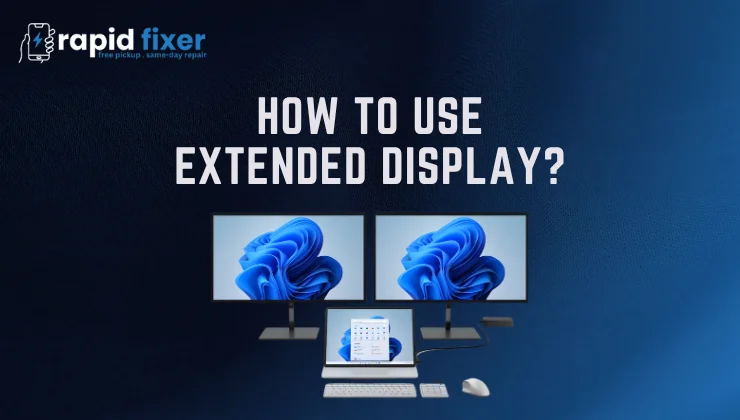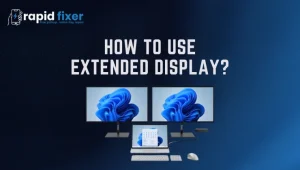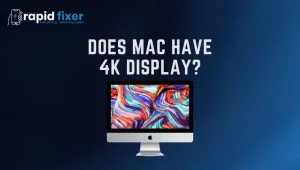One of the most efficient but easiest methods of enhancing modern productivity and workspace efficiency is How to use extended display. In case you have been wanting to be constrained on one monitor, you will find this feature an eye opener. You can choose to multitask, play video games more effectively, or more easily manage creative tools across several screens, and by expanding your display, you can transform a basic system into a business one.
Here in this detailed guide you will learn how to use extend display in Windows, how to extend display using HDMI and what will happen when you attempt to extend display using an HDMI splitter. You will also see helpful troubleshooting advice and set up examples to make the best experience possible.
Table of Contents
Why You Should Use an Extended Display
When you add a long screen, you increase the size of your desktop on two or more screens. This allows seeing various applications on the same screen and becoming more productive. Most professionals, gamers and students use extended displays due to the following reasons:
Better Multitasking
A longer display allows opening multiple programs simultaneously without having to switch tabs on a regular basis. You are able to access the web on one screen, work on another document, or maintain communication apps open, and work at the same time.
Improved Productivity
Research indicates that using two or multiple screens saves time because people do not need to switch between windows. You will be able to put one screen on emails and another on design or editing progress which will enable you to remain focused.
Enhanced Entertainment and Gaming
In the case of gamers, a large display would create a more immersive experience. Timelines, toolbars, and previews can be viewed using multiple screens by designers and video editors as well.
Professional Presentations
When you have to give a lot of presentations, you are better off with an extended display, which will enable you to privately handle the slides and notes on the primary display and present the presentation to your audience on the secondary display.
Preparing Your System for an Extended Display
Payment Before you begin to learn how to use extended display in Windows, you should ensure that your computer is configured to support more than one monitor.
Check the Available Ports
Check the sides or the back of your laptop or desktop PC. There are a few different kinds of ports that can be connected to a monitor. These most popular are HDMI, DisplayPort, USB-C, VGA, or DVI. DisplayPort and HDMI have the highest quality and cover high resolutions. When your computer has two or more video outputs, it can easily be used with long displays.
Verify Graphics Support
The graphics card (GPU) of your computer defines the number of displays that it supports. A majority of contemporary integrated or dedicated GPUs are dual or multi monitor capable. To prevent issues ensure that you have installed the latest drivers that are provided by your device manufacturer.
Use Adapters or Docking Stations if Needed
Just because your laptop has a single HDMI port does not mean that you cannot continue to use several screens with a USB-C hub or DisplayLink docking station or external graphics adapter. These devices can support more than one display in cases where your system has few ports.
How to Use Extend Display in Windows
Your hardware is all prepared, so now you have to configure your extended display in windows. These are the steps to follow to make the process smooth.
Connecting the Second Monitor
Connect the computer with a second monitor via HDMI, Displayport, or USB-C. When connected, power-up the monitor. Windows must automatically pick it up and display a new screen mode.
Choosing the Display Mode
Click Windows + P on your computer. There will be a side menu with four options:
- PC screen only
- Duplicate
- Extend
- Second screen only
Select Extend to enable extended display mode. This will combine your monitors into one large workspace and you can drag windows in one screen to another.
Arranging Your Displays
Click the right button of the desk and choose Display settings. Click Rearrange your displays under the Identify section it will display the number of the monitor as 1 or 2. The next step is to drag the boxes to the physical layout of your monitors. Customize the primary display, resolution, and scaling options. In this manner, you will get an ideal matched extended display system with the mouse cursor moving naturally among screens.

How to Extend Display Using HDMI
HDMI is commonly used as the connection type on most computers and laptops. It is easy to learn how to extend display with the use of HDMI, however, the limits are worth knowing.
Using a Direct HDMI Connection
Insert one of the ends of the HDMI cable in your laptop or desktop and the other end in your monitor. When connected, open Display settings and select Extend these displays. Change the resolution and scaling to suit your screens.
This technique is ideal when your device has a HDMI or DisplayPort out port(s) more than one. To illustrate, most desktop computers or the more sophisticated laptops have several output ports across the GPU.
Using USB-C or DisplayPort for More Screens
In case your computer has USB-C or DisplayPort, then better use it rather than HDMI. DisplayPort, specifically, has the ability to daisy-chain, i.e. to connect a series of monitors using a single cable via MST (Multi-Stream Transport).
Limitations of HDMI
One HDMI port is capable of providing one video signal at a time. This implies that in case you only have a single HDMI port and attempt to use a basic splitter to connect two monitors together, the two monitors will display the same picture rather than lengthening the desktop. This brings us to the second section.
How to Extend Display Using HDMI Splitter
Most users falsely believe that they can use HDMI splitter to extend display, yet this is not true.
What an HDMI Splitter Does
An HDMI splitter receives an HDMI output of your computer and replicates the signal to two or more monitors. It is ideal when you intend to present the same content on multiple screens, say, in a video presentation in the store.
Why HDMI Splitters Cannot Extend Displays
The HDMI interface is capable of transporting a single video signal at a time. This signal is duplicated at a basic splitter; this splitter does not generate two signals. Thus, splitting will not provide you with a long desktop, but will only be a reflection of your primary display.
Real Ways to Extend Displays
In order to extend displays, you require a solution capable of generating multiple video outputs. The best methods include:
- A graphics card that has two or more HDMI or DisplayPort connections.
- A DisplayPort MST hub with compatible monitors.
- A DisplayLink docking station or USB laptop graphics adapter with 1 HDMI.
These settings will make sure that the screens get different signals and you can utilize the extended display option accordingly.
Troubleshooting Extended Display Problems
After hooking up your monitors sometimes things do not work as desired. In case you are experiencing problems with display, the following are the typical issues and their fixes in detail.
Monitor Not Detected
In case windows fails to respond to the second monitor, enter Settings, System, Display, and turn to Multiple displays, click on Detect. It is also possible to verify the connection of the cable or port whether it is firmly connected. This can be solved by updating your graphics driver.
Display Only Mirrors Instead of Extending
Click Windows + P and choose Extend again. In case it still reflects, verify whether you are using an HDMI splitter, always bear in mind he is just copying displays.
Black Screen or No Signal
Make sure the cable you are using is the right cable to the monitor input. Attempt to reconnect or use a different HDMI or DisplayPort cable. Malfunctioning cables usually lead to black screens.
Incorrect Resolution or Scaling
Clipboard settings Open Display settings and rearrange Scale and Layout. The resolution and scaling of each monitor can be set individually depending on size.
Mouse Doesn’t Move Smoothly Between Screens
Reposition the displays in settings corresponding to the physical layout of the monitors. This makes sure your cursor moves rightly between screens.
Additional Tips for the Best Experience
A long display system is most effective when properly set up. Both monitors should have the same refresh rates and resolution, to achieve smoother performance. When you are working long hours, you can set the brightness, or Night Light or Eye Comfort mode on each display separately.
The monitors should be positioned at the same height to minimize the neck strain and where possible, the monitors should be mounted to a stand or on the wall. It will also be easier to maintain in the long run by keeping cables well organized and labeled.
Example Setups for Extended Displays
Home Office Setup
An external HDMI or USB-C dock that has a laptop is the best way to work remotely. Communication tools are on one screen and the other on a document or design work.
Gaming Setup
In the case of gaming desktops, you can directly connect a monitor through the HDMI to the GPU and another one through DisplayPort to the GPU. Play on a single screen and chat or stream on the other with the extended mode.
Presentation Setup
In classrooms or business presentations, the extended display mode can be used with the main presentation projected on a different monitor or projector, privately controlling slides.
Conclusion
Learning how to use extended display is needed to create a contemporary, effective, and comfortable digital workspace. You can very easily configure several monitors by using windows settings and the right HDMI/ Displayport connections. It is important to remember that HDMI splitters are only capable of duplicating your screen and not stretching it.
When your computer has fewer ports, it might be worthwhile to either add a DisplayLink docking station or an external adapter to increase your configuration. As soon as you set it up rightly, your extended display will simplify work, gaming, and presentations and make them more enjoyable.
FAQs About How to Use Extended Display
What Does Extend Display Mean?
It implies that your desktop is extended on two or more screens, where you can move windows and applications between the monitors.
How to Extend Display Using HDMI?
Plug your second monitor in using HDMI, click windows + p, and choose Extend and use the Display settings to alter the setting.
Can HDMI Splitter Extend Display?
No. HDMI splitters do not extend your screen, they duplicate it. To get an actual extended display, a docking station or a graphic card with multiple outputs is required.
How to Use Extend Display in Windows 10 or 11?
Open the System menu, go to Display, and down to Multiple displays, and click on Extend these displays in the drop menu.
Why Is My Second Monitor Showing the Same Screen?
Probably, this is because you are in Duplicate mode or you have a splitter. Fix it by changing it to Extend mode.


